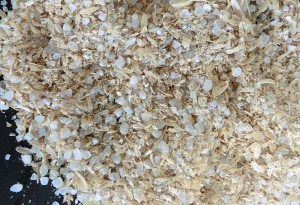
Ground unhulled rice (Courtesy of the Hyogo Prefectural Technology Center for Agriculture, Forestry and Fisheries)
Replacing all the corns used in mixed feed for pork pigs with ground unhulled rice was found to have no effect on growth of the pigs, according to the Hyogo Prefectural Technology Center for Agriculture, Forestry and Fisheries. Compared to the mixed feed, the feed cost can be reduced by 10 percent, and the amount of lipid like oleic acid also increased. As one pig consumes 300 kilograms of unhulled rice before it is shipped, the center proposes this as effective utilization of rice for animal feed that the government has tried to increase in production.
There were some cases in which some of the corns, whose prices remain at high levels, in mixed feed were replaced with barely, milos (sorghum) or ground brown rice. However, according to the center, there have been no test results in Japan of replacing all the corns with ground unhulled rice.
In the test, a total of 32 crossbred Sangenton (16 castrated, 16 sows) were used, and set up an unhulled-rice section and a mixed-feed section. The mixed feed consisted of corns (70 percent), soybean meal (20 percent), wheat bran, fish meal, and so on. In the unhulled-rice section, all the corns were replaced with ground unhulled rice, and the combination ratio other than the corns were not changed.
The amount of nutrient in ground unhulled rice which livestock can take as feed is lower than that of corns by 10 percent. With ground unhulled rice, the average weight the pigs gained a day was lower by 50 grams, but the difference could be offset by extending the fattening period by around 4 days. “The pigs ate less in the first half of the period, but they ate more in the latter half, which is important for weight gain,” the center said.
As a result of the comparative test, the feed cost was JPY15,591 per pig (unhulled rice was estimated as JPY32.4 per kilogram, and grinding, JPY10.8 per kilogram). The cost was decreased by JPY1,815 compared to the fattening with corn feed (JPY56.9 per kilogram).
The rating and quality of the meat were also improved. The pork pigs tested were graded numerically by 3, 2 or 1, and compared by the average points. The score of the unhulled-rice section was 2.6, exceeding the 2.1 of the mixed-feed section.
As for quality of the meat, the amount of oleic acid, which indicates the taste of the meat, increased, and the amount of linoleic acid were statistically low. Excessive taking of linoleic acid is considered to lead to lifestyle-related diseases. Feeding too much rice usually makes broilers’ meat whiter, but the meat color of the pork pigs didn’t change.
“There’s no problem if pigs can take enough nutrient from the feed as a whole. If you’re concerned about the effect, you can increase the ratio gradually. We can expect improvement of the meat quality according to the components of the feed,” said Masakazu Irie, a specialist on stockbreeding feed and professor at Faculty of Biology-Oriented Science and Technology of Kinki University. The center also changed all the corns for broilers to unhulled rice, and found that there were no effect on their growth and quality of their meat.
(Sept. 29, 2014)

